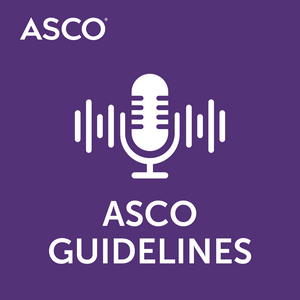ASCO Guidelines

187 episodios

Management of Cancer During Pregnancy Guideline
11/12/2025 | 34 min
Dr. Alison Loren and Dr. Ann Partridge share the latest guideline from ASCO on the management of cancer during pregnancy. They highlight the importance of this multidisciplinary, evidence-based guideline and overarching principles for the management of cancer during pregnancy. Drs. Loren and Partridge discuss key recommendations from each section of the guideline, including diagnostic evaluation, oncologic management, obstetrical management, and psychological and social support. They also touch on the importance of this guideline and accompanying tools for clinicians and how this serves as a framework for pregnant patients with cancer. The conversation wraps up with a discussion on the unanswered questions and how future evidence will inform guideline updates. Read the full guideline, "Management of Cancer During Pregnancy: ASCO Guideline" at www.asco.org/survivorship-guidelines TRANSCRIPT This guideline, clinical tools, and resources are available at www.asco.org/survivorship-guidelines. Read the full text of the guideline and review authors' disclosures of potential conflicts of interest in the Journal of Clinical Oncology, https://ascopubs.org/doi/10.1200/JCO-25-02115 Brittany Harvey: Hello and welcome to the ASCO Guidelines Podcast, one of ASCO's podcasts delivering timely information to keep you up to date on the latest changes, challenges, and advances in oncology. You can find all the shows, including this one, at asco.org/podcasts. My name is Brittany Harvey, and today I am interviewing Dr. Alison Loren from the Perelman School of Medicine of the University of Pennsylvania and Dr. Ann Partridge from Dana-Farber Cancer Institute, co-chairs on "Management of Cancer During Pregnancy: ASCO Guideline." Thank you for being here today, Dr. Loren and Dr. Partridge. Dr. Alison Loren: Thanks for having us. Dr. Ann Partridge: It's a pleasure. Brittany Harvey: And then just before we discuss this guideline, I would like to note that ASCO takes great care in the development of its guidelines and ensuring that the ASCO conflict of interest policy is followed for each guideline. The disclosures of potential conflicts of interest for the guideline panel, including Dr. Partridge and Dr. Loren who have joined us here today, are available online with the publication of the guideline in the Journal of Clinical Oncology, which is linked in the show notes. So then to dive into the meat of this guideline, to start us off, Dr. Loren, could you provide an overview of the scope and purpose of this new guideline on the optimal management of cancer during pregnancy? Dr. Alison Loren: Sure, thanks, Brittany. So this was really born out of I think a lot of passion and concern for this really vulnerable patient population. We have observed, and I am sure it is not any surprise to your audience, that the incidence of cancer in young people is increasing. And simultaneously, people are choosing to become pregnant at older ages, and so we are seeing more and more people with a cancer diagnosis during their pregnancy. And for probably obvious reasons, there is really no way to do randomized clinical trials in this population. And so really trying to assemble and articulate the best evidence for safely managing the diagnosis of cancer, the management of cancer once it is confirmed, being thoughtful about obviously the health of the mom, but also attending to potential risks to the developing fetus, and really just trying to be really comprehensive and balanced about all the choices for these patients when they are facing some really challenging decisions in a very emotionally fraught environment. And I think it is really emotionally fraught for the providers, too. You know, this is obviously an extremely intense, very emotional set of decisions, and so trying to provide a rudder essentially to sort of help people frame the questions and trying to make as evidence-based a set of recommendations as possible. Dr. Ann Partridge: And I would just add that "evidence-based" is a strong word here because typically our, as you just heard, our gold standard evidence is a randomized trial, but you can't do that in this setting, in general. And so, what we were able to do with the support of the phenomenal ASCO staff was to pull together kind of the world's literature on the safety and outcomes of treatments during pregnancy, as well as consensus opinion. And I think that is a really, really critical difference about this particular guideline compared to many of the other ones that ASCO does, where consensus and good judgment needed to kind of rule the day when evidence is not available. So, there is a lot of that in our recommendations. Dr. Alison Loren: That is such a good point. And I just, before we move forward, I just want to reflect that the composition of the panel was really broad and wide-ranging. We had maternal medicine specialists, we had legal and ethical experts, we had representatives who understand pharmaceutical industries' perspectives, and then medical oncologists representing the full spectrum of oncology diagnoses. And so it was a really diverse, in terms of expertise, panel, internationally composed to try to really get the best consensus that we could in the absence of gold standard evidence. Brittany Harvey: Absolutely. That multidisciplinary panel is really key to developing this guideline and, as you said, looking at the evidence and even though it does not reach the level of randomized trials, still critically evaluating it and reviewing that along with consensus to come up with optimal management for diagnosis and management of cancer during pregnancy. So then to follow that up, I would like to next review the key recommendations of the guideline across the main sections that the expert panel provided. First, I will throw this out to either of you, but what are the important general principles for the management of cancer during pregnancy? Dr. Ann Partridge: I think there were three major principles that we hammer home in the guidelines. One is that this is a team sport. It is multidisciplinary care that is necessary in order to optimize outcomes for the patient and potentially for the fetus. And that you really need to, from the beginning, bring in a coordinated team, including not just oncologists but obstetricians, maternal-fetal medicine specialists, neonatologists, ethics consultants, and obviously the patient and potentially her family. So that, I think, is one of the most important things. Second would be that obviously in a pregnancy, there are two potential patients and that the nuances of safety and risk from treatment is really wrapped up in where in the trimester of the pregnancy the patient is diagnosed, along with the kind of cancer that it is, both the urgency of treatment and the risk of the cancer, as well as the potential risks of any given intervention across the cancer continuum. It is a broad guideline in that regard. And then finally, and this is particularly timely given what is going on from a sociopolitical standpoint in the U.S., really thinking about informed consent and potential ethical as well as legal implications of some of the choices that patients might have when they are thinking about, in particular, continuing a pregnancy or potential termination. Dr. Alison Loren: And I will just add that I think that the key to all of this guidance is nuance and individualization and also making sure that patients and their care providers understand all the choices that are available to them and also the consequences of those choices. You know, nobody would choose to receive chemotherapy during pregnancy if that wasn't necessary. So there are risks to treatment, but there are also risks to not treatment. And making sure that in a suboptimal situation where you do not have a lot of evidence, trying to weigh, the best you can, the risks and benefits of all of the choices so that the patient can come to a decision about the treatment plan that is right for her. Brittany Harvey: Definitely. And those core concepts really set the stage for individualized care on what is necessary for appropriate multidisciplinary care, prioritizing both patient autonomy and informed decision making. With those core concepts and key principles in mind, I would like to move into the recommendations section of the guideline. So what are the key recommendations regarding diagnostic evaluation for pregnant patients with signs or symptoms of cancer? Dr. Alison Loren: I think the most important thing is to not delay, that there are very careful and well-thought-out recommendations for how to evaluate a potential cancer. And while there are certain things that we know can be harmful, particularly when certain dose thresholds are exceeded - for instance, abdominal imaging, there are certain radiographic thresholds that you don't want to exceed because of risk of harm to the embryo or fetus - there are still lots of options for diagnosing cancer during pregnancy. And again, thinking about the costs of not doing versus the cost of doing, right? It is really important to make the diagnosis of cancer if that is a consideration or a concern. And sometimes going directly to biopsies or getting definitive studies, even if there is a small risk to the developing fetus, is really essential because if the mom does not survive, of course, the fetus is also not going to survive. And so we need to be thinking first about the patient who is sitting in front of us, the woman who needs to know what is going on in her body so she can make good decisions about her health. So, I think that is a key principle in thinking about this. Brittany Harvey: Absolutely. So, following that diagnosis of a new or recurrent cancer, what is recommended for oncologic management of patients who are diagnosed with cancer during their pregnancy? Dr. Ann Partridge: So, I think the general principle is, again, cancer is such a wide number of diseases and even within diseases, a range of stages and risks and associated opportunities for risk reduction and/or treatment depending on the type of cancer. Just by example, in the work that I do, which is breast cancer, once someone has had a surgery in the early-stage setting, a lot of our treatment is about risk reduction. And that is very different than from what Alison does, which is treating people with leukemia, where it is kind of binary. If you do not treat, including with cytotoxic drugs, the patient and an unborn fetus will die, especially early in the pregnancy, obviously. So this is where cancers are very, very different. So I think taking the approach of what would you do if the patient were not pregnant? And what is the best treatment for that particular patient with that particular kind of cancer? And then applying the pregnancy and where the patient is in that pregnancy in terms of the trimester of the pregnancy, and what is safe and what is unsafe from the options that you would give her if she were not pregnant. And then if the patient is choosing to keep the pregnancy, which in my practice, many people come and they come to me because they want to hold onto their pregnancy and want to figure out how to make it work, coming up with a regimen that tries to give them kind of the best bang for the buck, the best possible breast cancer therapy with the least harm, when possible, to the fetus. It is a bit of a balance, right? And then we cannot always give people the best approach. And sometimes it comes down to making a decision to give up something that may improve their survival so as not to harm the fetus. And sometimes it goes the opposite direction where a patient will say, "Oh, that is going to improve my survival by 5% and you can't give it to me now? I am going to choose to terminate." Even though that is obviously a very, very difficult and challenging decision to make in this setting because they want to optimize their survival and ideally live on to potentially have another pregnancy in the future if that is something that is of interest to her. So these are really, really hard conversations as you can imagine, but that is kind of where we go. Dr. Alison Loren: Yeah, and I think this is where the need for more research and understanding is really key because sometimes questions come up. I guess I am thinking about like HER2-directed agents, which we know are contraindicated in pregnancy. But what about sequencing? Does it matter when you get it? Can you get it later? I think that is something that we don't really fully understand. And similarly, again, this is obviously like a breast cancer and blood cancer focused discussion because that is what we do, but thinking about managing blood cancers, certainly with acute lymphoblastic leukemia, there is actually a lot of options now that, you know, you could potentially use to temporize or sort of get somebody through a pregnancy relatively safely. I am focusing on the word "relatively" because we do not know what the long-term impact might be of potentially not optimal therapy in the long run. And then thinking about other things like timing of a bone marrow transplant relative to either delivery or termination. I mean, again, we really do not know what are the right sets of sort of timing considerations for those. So there are just a lot of unknowns. And I think trying to be sort of self-aware and humble and honest about those unknowns so that the patient can engage in the conversation in a way that is meaningful to her and make the decisions that make the most sense for her. I think the most important thing is to make sure that the patient feels supported and safe to make those decisions with as little regret as possible. Brittany Harvey: Yes, I think it is really important that you mentioned that there is a wide range of cancers here, and that means that care really needs to be individualized for each patient. I will also note, just in this section, that I found really informative while reading through the guideline the list of oncologic agents that may be offered in each individual trimester, whether it is contraindicated or it can be used with caution, or if there is relatively good safety data on it for prioritizing maternal treatment needs and balancing fetal safety at the same time. I think that is, that is really key. And I think readers will really like that section of the guideline to provide concrete information for them and their patients. Dr. Alison Loren: Thank you. We actually spent a lot of time on that table and just thinking about what it should look like, what the format ought to be, what the language ought to be. Because of course, at the end of the day, everything should be used with caution. So what does that actually mean? And we sort of tried to explicate that a little bit in like the footnotes. We really tried to leverage what we know from clinical experience, from package labels, from mechanism of action to try to be as clear and definitive as we could be without overstating or understating what we know. Dr. Ann Partridge: Yeah, and I think we are focusing on breast and leukemia because that is what we do. But the truth is much of the data comes from those two areas. Leukemia, not because it is so common, but because you do not really have choices to treat or not treat. And so for decades, they have been treating and saying, "We hope the progeny comes out okay." And for many agents it does. The babies are okay. And so, we have reasonable observational data. And then in breast cancer, there have been actually some prospective registry-type studies where people have been followed and treated when pregnant, and the progeny have been accounted for, and so we have some good experience in that way too. Again, not randomized trials, but at least data that suggests certain agents are safe. And increasingly, because of that, when we have had to treat patients, we have said, "Okay, let us do it on this registry so that we can at least learn from every patient that comes in in this situation." And so, I think we will have more and more data given the growing number of young adults with cancer and the delays in childbearing that are happening around the world, and particularly in Westernized countries. I wish we did not. We wish we did not see this problem, but of course, when we do, we have to make sure that we learn from it and try and get patients enrolled in these registries and any kinds of studies that are available. Dr. Alison Loren: Yeah, I will just underscore that to say that, you know, there is outcomes of pregnancy and then there is outcomes of pregnancy, right? So there is like, "Okay, the baby was born with 10 fingers and 10 toes, and they passed their Apgar, and they are doing all their developmental processes along the way." But what happens when they are 10 or 15 or 20? Are they maturing normally? Are they cognitively intact? And then, of course, it is really inseparable from what is the impact on a family of having the mom with cancer? And how does that impact childhood development and intellectual development? And so these are really, really important questions that are very difficult to answer given the longitudinal information that you need, but it is a really critical question that, you know, patients ask and we do not know the answer. Dr. Ann Partridge: Yeah, that actually leads me to one of the important principles in the guideline that is a little bit of a change from when I first started practicing, which is we have learned from the wider neonatology literature, as they have followed up on the children that were born prematurely, that it is actually better not to be premature and to keep the baby in utero as long as it is safe for the fetus and the mother as long as possible, ideally to term rather than delivering early and then giving the chemo after that or separating the chemo from before and after. We used to try and deliver early and then give agents, but now we typically will give agents that are safe to be given at the end of pregnancy, ideally close to term, a couple weeks out, to allow for the ability of count recovery, and you do not want to go into preterm labor with chemotherapy on board, but we used to go much earlier and have an argument with our maternal-fetal medicine doctors. "How early can you get them out?" And they would say, "How long can they stay in?" And increasingly, we have been able to try and compromise to go even later and allow the fetus to go to term because of the neonatal outcomes that in longer term there is a suggestion that the children are developing better in the long run if they are kept in utero for as long as possible. Dr. Alison Loren: Yeah, that is such a great point. I think that is probably the most important thing for people to take away. For anyone who sort of does this, I mean, no one does this regularly because it is a rare event, although I think it is increasing as I mentioned. But this idea that the third trimester is, most of us know, is primarily a time for growth. Most of the critical development has already occurred, and so administering most chemotherapy agents towards the end of the third trimester seems to be preferable long term than delivering them early. So that is a really big change. I think we used to try to sort of, "Oh, get them to 30 or 32 weeks and then deliver," but we really are trying to get them closer to term, 37 weeks or more, and then coordinating the treatment so that they are not nadiring, as Ann said, at the time of planned delivery. Brittany Harvey: Yes, and that is a really important point related to evidence-based care and why we have changed that practice. And so then that actually leads nicely into my next question. But as you both mentioned, this is an important collaboration between oncologists and obstetricians. So the next section of the guideline addresses obstetrical practice. And so beyond what is standard, what additional recommendations are there in obstetrical management for pregnant patients with cancer? Dr. Alison Loren: That is a great question. So I will say we were really struggling with like how much do we cover? Like this is an oncology guideline. We are not obstetricians. We certainly had great representation from our maternal-fetal medicine colleagues on the panel. But really trying to sort of give useful information without overstepping. And so I think that the main recommendations are to increase the frequency of fetal monitoring, make sure that there is close attention to blood counts in the patient. But I think there is really still a gap in terms of what we know about optimal management of a pregnant person who is receiving therapy and how to handle the pregnancy itself. The delivery should be a usual delivery. Our colleagues did not recommend a planned C-section. They recommended usual care in terms of planning for the delivery. Obviously, if a C-section is indicated, then it should be done, but it should not be planned this way because of the cancer diagnosis. And I guess the other thing that we mentioned in the guideline, although we were reluctant to push it too hard because of access to these specialized services, was evaluating the placenta after birth to ensure that there were no metastases in the placenta itself. Dr. Ann Partridge: Those are the main things, and judicious and prudent obstetrical care, as I think, you know, is trying to be practiced regularly with MFM. Typically these patients should be followed not by your average OB/GYN, but a maternal-fetal medicine specialist because these patients will have special concerns, especially if they are sick. So oftentimes, especially Alison's patients, are actually sick with leukemia. And so you are monitoring them a lot, whereas, you know, a breast cancer patient typically isn't sick, although they could get sick with their chemotherapy. And so we really want to hand-in-hand manage these patients with our MFM colleagues. Dr. Alison Loren: I think we also highlighted in the guideline just for the refresher purposes of the oncology community, generally which drugs that would be given in a normal oncology setting are safe to be given to a pregnant person. So we talked a little bit about what kinds of steroids are recommended, antiemetics, DVT prophylaxis, peripartum. These are things that we think about a lot in oncology, but just want to make sure that it sort of intersected appropriately with the care of a pregnant patient. Brittany Harvey: Definitely. That specialized care is really important for patients who are pregnant and have cancer. And then the last section of the recommendations addresses psychological and social support. As you both mentioned before, this is a highly emotional time and it can be difficult and challenging to make decisions. So what is recommended for the psychological and social support of pregnant patients with cancer? Dr. Ann Partridge: Well, as I said, it is really something that needs to be considered at the beginning, through the diagnostic period, all the way into survivorship. Ironically, even though it is a highly fraught, emotional situation, I find that my pregnant patients actually are extraordinarily resilient, and what they are really focused on often is the safety of the fetus, because again, many of the people that come to me, it is a highly wanted pregnancy. They are also focused on their own health, of course, and often you need to bring in social work, sometimes a psychologist, professionals who are there just to help manage their emotions while we are focusing on what do they need medically to be as healthy as possible, both for the again, the mother, the patient, and the fetus. It is very tricky, and I will say also bringing in sometimes people on the ethics team in the hospital to help, both from the "Are you recommending and giving something that is safe?" That is number one. And then number two, sometimes patients want to be treated with drugs that we do not have any safety data for in pregnancy. What are our obligations? I think most of us would say we would not treat someone if we do not have safety data and there is suspicion for concern. But where is that line in terms of the right thing to do by that patient? And so we are all beholden to our ethics colleagues to help us when we make decisions like that. You know, we all want to do right by the patient, but we have to uphold our oaths and legal obligations. I don't know if you have to add on that because it's very tricky. Dr. Alison Loren: It is, it is very hard. I mean, I think, you know, there is a lot of emotion, obviously any cancer diagnosis is extremely charged and people are already at sort of a heightened, you know, they are anticipating a new baby and planning around that. And so it is just an extremely disruptive is the smallest word I can think of to describe it. And I think that often there is a co-parent, there might be parents and in-laws and other siblings, and then there is care after delivery. And so it is just a very complex set of dynamics. And having both our ethics colleagues and our psychology and social work colleagues to sort of just pitch in and make sure that the patient is being supported. I think there are sometimes really difficult situations where maybe what the patient wants is different from what the father of the baby wants or what the rest of the family wants. And so that can be really challenging. And you never really know where those landmines are going to pop up. So it is good to have the team on board early and often. Dr. Ann Partridge: Yeah, I would add to that, the other thing here that I think is really important, like in all of medicine but especially in situations like this, this is where we have to be very careful as professionals not to impose our own ethical, moral, emotional, personal views on the patient and to try to reserve judgment as much as possible. We are their navigator with the most important evidence and information that we can provide in the current situation. And that is where this guideline is extraordinarily helpful, we hope, for clinicians in the years to come. And at the same time, we cannot necessarily impose our own views and what we would do on a patient or what we tell our daughters, sisters, friends, family members. It is very tricky in that way. And so sometimes not just support for the patient, but support for the care team may be warranted in some of these very fraught situations. Dr. Alison Loren: Yeah, that is such a great point. And I was sort of thinking that too. I mean, it is, of course, the patient is front and center, but these are really difficult situations to navigate. And I will just add also that a lot of times these patients end up in academic centers, which I think is that's where the expertise or even just the experience may be. But the downside of that is that, you know, the teams are constantly changing. You have a new resident, you have a new intern, you have a new attending, a new fellow. And so, you know, the patients may be subjected to lots of different ways of communicating and sometimes those perceived differences can be really challenging. So sort of team huddles to sort of make sure that everybody is reading from the same script and everyone is comfortable with how the information is being presented so that the patient does not feel more confused or more overwhelmed, that they are kind of getting a consistent message from the whole team that, "This is what we know, this is what we are recommending, here are your other choices, and here are the pros and cons of each of these options." Brittany Harvey: Yes, I think you have both touched on this and that bringing in appropriate experts to support both clinicians and patients and their decision-making and their mental health is really important for this section of the guideline. We have already discussed this a fair bit throughout our conversation, but in your view, what is the importance of this guideline and how will it impact both clinicians and pregnant patients diagnosed with cancer? Dr. Ann Partridge: I could start with that. We just talked about experts and having them all around, but the fact is most people do not have the experts all around when they are dealing with this. And I think this is, you know, an expert-based, evidence-based guideline where having this in one's back pocket, whether you are in rural Montana or at a major cancer center on either coast, you will be armed with the latest and the greatest in terms of what we know and what we do not know, and some very helpful algorithms for how to think through the process of dealing with a patient who is diagnosed during pregnancy, whichever type of cancer it is. We could not cover every single specific thing about every cancer, although it is a pretty long guideline and there is a lot of nuance in there. So you might find a lot about specific cancers. And I think that that will be very, very helpful for people who are faced with this situation in the clinics just to frame it out, think through. Sometimes there is no answer that is the perfect answer and then, you know, using this as kind of a scaffolding and phoning a friend who may have more experience to help guide you and guide the patient, most importantly. I think it will be very helpful in that regard. Dr. Alison Loren: Yeah, I think so too. And I have talked about that we are working on this guideline and the anecdotal feedback has been, "This is so helpful." Like there really has not been, I think, an all-in-one place, diagnostic considerations, radiographic considerations, staging, treatment, all the modalities, surgical, radiation, systemic chemotherapy. We tried to include, when we could, novel agents including targeted agents and monoclonal antibodies and bispecifics and cellular immunotherapies and non-cellular immunotherapies. We really, really tried to cover in 2025 what are people using to treat cancer and to try to give the most balanced view of what we think is is safe or reasonably safe and what we think is either unproven or known to be risky, really to have it be kind of a go-to, like all-in-one, as much information as we have about these really challenging cases. We tried to include, Ann mentioned, you know, specific cancers, and I think when there were specific things to shout out with specific cancers, we really tried to highlight that. Like, "Okay, lots of young patients with cancer have Hodgkin's lymphoma, so what is safe and what is not for that specific case?" Or, "What is safe or what is not when you are thinking about colon cancers?" And we have a shout-out in here about considering checking for DPD deficiencies in patients who are pregnant. And I know it is generally recommended nowadays, but certainly for people who are pregnant, you know, you really want to avoid excess toxicity. So I think just really trying to be attentive to specifics about certain cancers in young patients and what would be valuable for a practicing oncologist and obstetrician to know when you are faced with this situation. Dr. Ann Partridge: Yeah, and I think the other critical thing that is great about this guideline is it's a starting place. And I anticipate that we will be building on this guideline for many years to come. And remember that when first, I was not around then, but probably three or four decades ago, when chemotherapy was just coming out and patients were coming in pregnant, there was a feeling I am sure that was, "We cannot give this to this person because it is purposefully going to destroy cells. And when you destroy cells in a growing fetus, you are going to destroy or harm that fetus." And yet, people did not have great choices. It was get treated or die, especially with things like leukemia early on. And bold patients along with their oncologist said, "Bring it on." And that is how some of this literature has been born. And so moving forward, there will be either purposeful exposures or inadvertent exposures of some of our therapies where we will learn ultimately. And this is a place where we can update these guidelines. That is the beautiful thing about the ASCO guidelines is that they are constantly being thought about to be updated. And then when there is enough of a change in practice, they will be updated such that they will continue to inform how we do this in the years to come for patients who come in pregnant. Dr. Allison Loren: Yeah, and I will say I have been doing this long enough now, we were just talking about a different guideline, the fertility guideline earlier today, and over the 20 years that the fertility guidelines have been out, just the amount of research has really skyrocketed. And you can see as you look at each guideline how much we have learned, what we can say, "Yes, this is working," "No, this is not working." Like, it is stuff that we used to say, "Oh, we do not really know," and now we have answers. I think I speak for both of us when I say that we are hopeful that this will serve as, as Ann said, as a starting off point and really inspire people to ask the questions and do the research so that we can give better guidance moving forward, really trying to think about, you know, mechanisms and leaning on our colleagues in pharma and in the government who sort of think about safety and efficacy, to sort of make sure that they are contemplating not just non-pregnant patients, but also pregnant patients or as they are thinking about marking the package inserts with safety guidelines around this. Brittany Harvey: Yes, this is a critically important first guideline on the management of cancer during pregnancy, and we will look forward to continuing to build on that. I think as you mentioned, this guideline is far-reaching and has a lot of recommendations in it. And so both the full text of the guideline and those at-a-glance algorithms, figures, and tables will be really useful for clinicians in their clinic. Finally, to wrap us up, we have just been discussing this a little bit, but specifically, what are the outstanding questions on the management of pregnant patients with cancer, and where is this further research needed? Dr. Alison Loren: There are lots and lots and lots of unanswered questions. And I think if you look at the table, most of what we say is, "We are pretty sure this is okay, we are not so sure about this." I am paraphrasing, but we really just are operating in a paucity of what we would normally consider gold-standard evidence. It is hard to imagine, of course, there would ever be, as we mentioned in the beginning, randomized trials. But I think that preclinical data, mechanistic data, trying to think about including as we go through animal data, making sure that we are looking at female animals and pregnant animals so that we can sort of fully understand what the impact may be. And then I think thinking about more localized therapies around sort of radiation, you know, we are now moving into really hyper-focused radiation treatments like protons. Is that better because there is less scatter? Like I think those are real considerations that we just do not know the answer to. What do you think? Dr. Ann Partridge: I think so many unanswered questions, and this is a call to action to continue to and increase the documentation of the experiences and outcomes for patients diagnosed during pregnancy. Dr. Alison Loren: Yeah, and I think the long-term outcomes too are really going to be critical. Brittany Harvey: Yes, we will look forward to learning about more evidence across the spectrum of care to inform future updates to this guideline. So I want to thank you both so much for your work to develop this guideline, to review the extensive amounts of literature that you did, and work to create this guideline. And thank you also for your time today, Dr. Loren and Dr. Partridge. Dr. Alison Loren: Thanks. It was fun. Dr. Ann Partridge: Yeah, thank you. Brittany Harvey: And finally, thank you to all of our listeners for tuning into the ASCO Guidelines Podcast. To read the full guideline, go to www.asco.org/survivorship-guidelines. You can also find many of our guidelines and interactive resources in the free ASCO Guidelines app, which is available in the Apple App Store or the Google Play Store. If you have enjoyed what you have heard today, please rate and review the podcast and be sure to subscribe so you never miss an episode. The purpose of this podcast is to educate and to inform. This is not a substitute for professional medical care and is not intended for use in the diagnosis or treatment of individual conditions. Guests on this podcast express their own opinions, experience, and conclusions. Guest statements on the podcast do not express the opinions of ASCO. The mention of any product, service, organization, activity, or therapy should not be construed as an ASCO endorsement.

Management of Antineoplastic Extravasation: ONS-ASCO Guideline
18/9/2025 | 13 min
Dr. Tanya Thomas and Dr. Aparna Jotwani join the podcast to discuss the new Oncology Nursing Society and American Society of Clinical Oncology evidence-based guideline on the management of antineoplastic extravasation. They discuss recommendations from the expert panel on: management of extravasation of vesicant or irritant with vesicant properties antineoplastic agents, management of extravasation of paclitaxel or docetaxel, use & duration of thermal compress, and escalation of care. They share the importance of this comprehensive interdisciplinary guideline, highlight the algorithm as a useful tool for clinicians, and outline the outstanding questions related to the management of extravasation. Read the full guideline, "ONS/ASCO Guideline on the Management of Antineoplastic Extravasation" at www.asco.org/supportive-care-guidelines TRANSCRIPT This guideline, clinical tools, and resources are available at www.asco.org/supportive-care-guidelines. Read the full text of the guideline and review authors' disclosures of potential conflicts of interest in the JCO Oncology Practice, https://ascopubs.org/doi/10.1200/OP-25-00579 Brittany Harvey: Hello and welcome to the ASCO Guidelines podcast, one of ASCO's podcasts delivering timely information to keep you up to date on the latest changes, challenges, and advances in oncology. You can find all the shows, including this one, at asco.org/podcasts. My name is Brittany Harvey, and today I'm interviewing Dr. Tanya Thomas, clinical chair of the guideline and clinical nurse specialist from University of Virginia Health, and Dr. Aparna Jotwani, medical oncologist from Baylor College of Medicine, authors on "Management of Antineoplastic Extravasation: Oncology Nursing Society – American Society of Clinical Oncology Guideline." Thank you for being here today, Dr. Thomas and Dr. Jotwani. Dr. Aparna Jotwani: Thank you. Dr. Tanya Thomas: Thank you for having us. Brittany Harvey: And then before we discuss this guideline, I'd like to note that ASCO takes great care in the development of its guidelines and ensuring that the ASCO conflict of interest policy is followed for each guideline. The disclosures of potential conflicts of interest for the guideline panel, including Dr. Thomas and Dr. Jotwani, who have joined us here today, are available online with the publication of the guideline in JCO Oncology Practice, which is linked in the show notes. So then to dive into the content here, Dr. Thomas, could you start us off by providing an overview of both the scope and the objectives of this guideline? Dr. Tanya Thomas: Yes, so the objective of this guideline is to provide the evidence-based recommendations to help support our interdisciplinary teams, including the oncologist, the advanced practice providers, pharmacists, and nurses who are involved in the care and management of patients who are experiencing an extravasation of an antineoplastic agent. While rare, the antineoplastic and certain chemotherapy extravasations are oncologic emergencies. The recommendations are to minimize negative consequences and provide a standardized approach to the care when such an event occurs. Dr. Aparna Jotwani: I would add that our scope is limited to intravenous antineoplastic vesicants, irritants, and irritants with vesicant potential. The scope of the guideline applies to the care team for adult oncology patients receiving treatments through venous access. Outside the scope is management of extravasation during other routes of treatment administration, such as intraperitoneal, intravesical, and hepatic arterial infusion. Our recommendations regarding vascular access for therapy or interventions to prevent extravasations are also outside of the scope for this guideline. Brittany Harvey: Understood. I appreciate that background and understanding what's in scope and what's out of scope for this guideline. So then I'd like to pivot and talk about the key recommendations of this guideline across the clinical questions. So first, Dr. Jotwani, what does the panel recommend for patients with extravasation of vesicant or irritant with vesicant properties antineoplastic agents? Dr. Aparna Jotwani: The panel strongly recommends for all classes where an antidote exists to proceed with using the antidote. Recommendations for paclitaxel and docetaxel are specifically addressed in a recommendation. This is further detailed in Tables 1 and 4 within the guideline. Evidence on the use of antidotes for extravasation is limited to nonrandomized, uncontrolled, observational studies and case series. Placebo-controlled trials on this topic would be unethical. There is also a lack of comparative data for different antidote strategies. However, potential benefits of using the antidotes include tissue preservation and avoiding tissue necrosis. In developing the guidelines, we had an in-person roundtable discussion and weighed risks and benefits to ensure patient safety above all else. Brittany Harvey: I appreciate that description of the recommendation here. So then you just mentioned that there's a specific recommendation for paclitaxel and docetaxel. So what is recommended for those patients with extravasation of paclitaxel or docetaxel? Dr. Aparna Jotwani: So here, we conditionally recommended the specific use of hyaluronidase as the antidote. This was based on five studies that all used hyaluronidase as an antidote to lower the risk of tissue necrosis. In the studies included, with a subgroup of patients that experienced taxane-related extravasation, development of necrosis ranged from 0% to 0.83% among the patients who received an antidote. The potential harms associated with this were likely trivial. Brittany Harvey: Thank you for providing that recommendation as well. So then the next section of the guideline, Dr. Thomas, what does the expert panel recommend for use and duration of thermal compress? Dr. Tanya Thomas: So the expert panel actually recommends the use of thermal compresses, and the recommendations are based on the available literature for the various agents and the actual time frames most frequently used for the compress application. The utilization of a thermal compress is recommended for 15 to 20 minutes at a time for 3 to 4 times daily, at least for the first 48 to 72 hours after that extravasation occurs. The actual frequency and duration may vary based on the extent of the extravasation and the agent involved in that extravasation. The intent of the warm compress is to help disperse the agent and reduce the localized accumulation of the agent, whereas the cold compress, it actually helps prevent the dispersion or the spread of the agent while allowing the antidote to help neutralize that agent. Warm compresses are recommended for extravasations involving the vinca alkaloids, etoposide, oxaliplatin, and the taxanes - paclitaxel and docetaxel - only when coadministering the antidote hyaluronidase. The use of a cold compress is actually recommended for extravasations involving the anthracyclines, antimetabolites, alkylating agents, and taxanes when coadministration of the antidote hyaluronidase does not occur. Brittany Harvey: Understood. Those specific and actionable recommendations are really key for clinical practice. So then, following those recommendations, how does the guideline address escalation of care and surgical referral for patients with central line extravasation? Dr. Tanya Thomas: So this topic actually had a lot of discussion. And while there is not enough evidence to make strong recommendations, the expert panel recognized that surgical referrals should be considered in certain scenarios. Dr. Aparna Jotwani: We discussed that certain scenarios would include high-risk populations, such as patients that are receiving DNA-binding vesicants, those with high-volume estimated extravasation, and those with CTCAE grade 2, which would be erythema associated with symptoms such as edema, pain, induration, and phlebitis, or grade 3, which would be symptoms of ulceration or necrosis or concern for severe tissue damage, or grade 4, where you would have a life-threatening consequence extravasation, may have a greater likelihood of benefiting from surgical referral and/or escalation of care as deemed appropriate. Brittany Harvey: Great. And yes, it's really important to provide all of these recommendations that you've both just gone through, even when we're faced with very low evidence. So then, Dr. Thomas, in your view, what is the importance of this guideline, and how will it impact clinical practice? Dr. Tanya Thomas: So when extravasations occur in the clinical setting, members of the interdisciplinary team can be faced with barriers related to where to look for the information, how to find all the relevant information in one concise place, how to provide education to the patient about how to care for the site of extravasation in the home setting, and also when to escalate to specialized teams. This can actually cause some added stress and anxiety, and in certain circumstances, may lead to delays in efficient management. This guideline provides the resource clinicians have been looking for. It includes comprehensive recommendations for antineoplastic extravasations in one guideline while also providing a one-page algorithm with the key information regarding the management of the extravasations. This allows all levels of providers to have evidence-based recommendations regarding initial management of the extravasation, for instance, how to manage the infusion, key site assessment reminders, available antidotes, and the use of thermal compress; the required documentation, recommended follow-up scheduling, in addition to key aspects of the patient education. This type of guidance is not found in any other single document regarding antineoplastic extravasation. Having this document readily available at the point of care potentially can reduce time required for providers to search for management recommendations and also provide consistency in patient education and follow-up management scheduling. It reduces uncertainty within interdisciplinary teams and can help inform policy development for clinicians to approach extravasations with confidence. Brittany Harvey: Absolutely. I agree that this is an incredible resource for clinicians with the recommendations, the algorithm that you mentioned, and the supporting evidence that underpins these recommendations to really provide both efficient and effective care for patients. So beyond the impact for clinical practice, Dr. Jotwani, how will these guideline recommendations affect patients receiving antineoplastic treatment for cancer? Dr. Aparna Jotwani: Exactly. In addition to the clinical care team, we want to help and benefit our patients. So, oncology patients that experience extravasations are at risk for, aside of the side effects of tissue necrosis and infection, they also are at risk for delay of cancer treatment. In making these guidelines, we kept in mind the cost and the efforts for patients, additional visits that they could incur, additional time and supplies for care of the extravasation, as well as cost. Our guideline aims to provide an evidence-based approach to the care of oncology patients receiving antineoplastic intravenous therapy. While there are gaps in the data due to the nature of these events, based on careful literature review, these guidelines serve as a basis for quality, standardized oncology care during extravasation. Personally, I hope our graphics especially can be used across the systems to guide clinical care. Brittany Harvey: Definitely. We hope that these recommendations improve treatment and treatment outcomes for all patients receiving antineoplastic treatment for cancer. So then you've also just mentioned some gaps in the literature. So Dr. Thomas, I'd like to turn to you to wrap us up and ask, what are the outstanding questions for the management of antineoplastic extravasation? Dr. Tanya Thomas: Yes, that's a good question. Two of the main outstanding questions are related to the management of extravasations involving the novel agents and extravasations involving multi-agent regimens. The current literature regarding how to effectively manage the multi-agent regimens, for instance, there is no clear guidance for managing the extravasation for someone who is receiving a regimen that involves simultaneous administration of, let's say, a vinca alkaloid and an anthracycline. One of those agents requires a warm compress while the other requires a cold compress, and there are different antidotes for those two agents. Additionally, there has not been a lot of published information on the impact of extravasation of those novel agents like the antibody-drug conjugates. With the pace of the drug development, a subgroup of the guideline panelists actually are exploring case reports specific to novel agents to help inform some future work. Brittany Harvey: Yes, we'll look forward to learning more about how to address these ongoing issues and potentially impact guideline recommendations in the future as well. So I want to thank you both so much for your work to develop this incredibly important guideline, and thank you for your time today, Dr. Thomas and Dr. Jotwani. Dr. Aparna Jotwani: Thank you for the opportunity. Dr. Tanya Thomas: Yes, thank you. Brittany Harvey: And finally, thank you to all of our listeners for tuning in to the ASCO Guidelines podcast. To read the full guideline, go to www.asco.org/supportive-care-guidelines. I also encourage you to check out the companion episode on this guideline on the ONS podcast, available on Amazon Music, Apple Podcasts, Spotify, and YouTube Music. And finally, you can also find many of our guidelines and interactive resources in the free ASCO Guidelines app, which is available in the Apple App Store or the Google Play Store. If you've enjoyed what you've heard today, please rate and review the podcast and be sure to subscribe so you never miss an episode. The purpose of this podcast is to educate and to inform. This is not a substitute for professional medical care and is not intended for use in the diagnosis or treatment of individual conditions. Guests on this podcast express their own opinions, experience, and conclusions. Guest statements on the podcast do not express the opinions of ASCO. The mention of any product, service, organization, activity, or therapy should not be construed as an ASCO endorsement.

Postmastectomy Radiation Therapy: ASTRO-ASCO-SSO Guideline
16/9/2025 | 15 min
Dr. Kathleen Horst, Dr. Rachel Jimenez, and Dr. Yara Abdou discuss the updated guideline from ASTRO, ASCO, and SSO on postmastectomy radiation therapy. They share new and updated recommendations on topics including PMRT after upfront surgery, PMRT after neoadjuvant systemic therapy, dose and fractionation schedules, and delivery techniques. They comment on the importance of a multidisciplinary approach and providing personalized care based on individual patient characteristics. Finally, they review ongoing research that may impact these evidence-based guidelines in the future. Read the full guideline, "Postmastectomy Radiation Therapy: An ASTRO-ASCO-SSO Clinical Practice Guideline" at www.asco.org/breast-cancer-guidelines" TRANSCRIPT This guideline, clinical tools, and resources are available at www.asco.org/breast-cancer-guidelines. Read the full text of the guideline and review authors' disclosures of potential conflicts of interest in the Journal of Clinical Oncology, https://ascopubs.org/doi/10.1200/JCO-25-01747 Brittany Harvey: Hello and welcome to the ASCO Guidelines podcast, one of ASCO's podcasts delivering timely information to keep you up to date on the latest changes, challenges, and advances in oncology. You can find all the shows, including this one, at asco.org/podcasts. My name is Brittany Harvey, and today I am interviewing Dr. Kathleen Horst, expert panel chair from Stanford University; Dr. Rachel Jimenez, expert panel vice chair from Massachusetts General Hospital; and Dr. Yara Abdou, ASCO representative from the University of North Carolina, authors on "Postmastectomy Radiation Therapy: An American Society for Radiation Oncology, American Society of Clinical Oncology, and Society of Surgical Oncology Clinical Practice Guideline." Thank you for being here today, Dr. Horst, Dr. Jimenez, and Dr. Abdou. Dr. Kathleen Horst: Thank you for having us. Brittany Harvey: And then just before we discuss this guideline, I would like to note that ASCO takes great care in the development of its guidelines and ensuring that the ASCO conflict of interest policy is followed for each guideline. The disclosures of potential conflicts of interest for the guideline panel, including Dr. Horst, Dr. Jimenez, and Dr. Abdou who have joined us here today, are available online with the publication of the guideline in the Journal of Clinical Oncology, which is linked in the show notes. Then to dive into the content that we are here today to talk about, Dr. Horst, could you start us off by describing what prompted the update for this joint guideline between ASTRO, ASCO, and SSO, and what is the scope of this 2025 guideline on postmastectomy radiation therapy? Dr. Kathleen Horst: Thank you. This joint guideline was last updated in 2016. Over the past decade, the treatment of breast cancer has evolved substantially. Newer systemic therapy regimens have increasingly personalized treatment based on tumor biology, and local therapy management has explored both the de-escalation of axillary surgery and more abbreviated courses of radiation therapy. Given these advances, it was important to revisit the role of postmastectomy radiotherapy in this modern era of breast cancer therapy. This updated guideline addresses four key questions, including postmastectomy radiation therapy after upfront surgery as well as after neoadjuvant systemic therapy. It also reviews the evolving role of various dose and fractionation schedules and optimal treatment techniques and dose constraints. Brittany Harvey: Excellent. I appreciate that background, Dr. Horst. So then, next, Dr. Jimenez, I would like to review the recommendations of this guideline across those four key questions that Dr. Horst just mentioned. So first, what does the panel recommend for PMRT for patients who received initial treatment with mastectomy? Dr. Rachel Jimenez: The panel provided pretty strong consensus that patients with positive lymph nodes or patients with large tumors involving the skin or the chest wall should receive postmastectomy radiation. However, the panel also recognized that the omission of postmastectomy radiation may be appropriate for select patients who have positive lymph nodes and have an axillary lymph node dissection if they have a low nodal burden and other favorable clinical or pathologic features. For patients without lymph node involvement at the time of surgery and no involvement of the skin or chest wall, postmastectomy radiation was not advised by the panel. Brittany Harvey: Understood. It is helpful to understand those recommendations for that patient population. Following that, Dr. Abdou, what are the key recommendations for PMRT for patients who received neoadjuvant systemic therapy before mastectomy? Dr. Yara Abdou: When we think about PMRT after neoadjuvant treatment, the key point is that the initial stage of presentation still matters a lot. So for example, if a patient comes in with more advanced disease, say a large primary tumor, like a clinical T4, or more extensive nodal disease, like an N2 or N3 disease, those patients should get PMRT, no matter how well they respond to neoadjuvant therapy, because we know it reduces the risk of recurrence and that has been shown pretty consistently. On the other hand, if there are still positive lymph nodes after neoadjuvant treatment, basically residual nodal disease, PMRT is also strongly recommended because the risk of local-regional recurrence is much higher in that setting. The gray area is the group of patients who start with a lower burden of nodal disease, such as N1 disease, but then become node negative at surgery. For those patients, we tend to individualize the decision. So if the patient is young or has triple-negative disease, or if there is a lot of residual disease in the breast even though the nodes are cleared, then radiation is probably helpful. But if everything has melted away with pCR in both the breast and the nodes, then it may be safe to omit PMRT in those patients. For patients with smaller tumors and no nodal involvement to begin with, like a clinical T1-T2 N0, if they are still node negative after neoadjuvant treatment, then PMRT is generally not recommended because their baseline recurrence risk is low. And finally, if the margins are positive and cannot be re-excised, then PMRT is recommended after neoadjuvant therapy. Brittany Harvey: Yes, those distinctions are important for appropriate patient selection. So then, Dr. Horst, we have just reviewed the indications for PMRT, but for those patients who receive PMRT, what are the appropriate treatment volumes and dose fractionation regimens? Dr. Kathleen Horst: The guideline addresses coverage of the chest wall and regional nodes with a specific discussion of the data regarding internal mammary nodal irradiation, which has been an area of controversy over many years. The guideline also reviews the data exploring moderate hypofractionation, or shorter courses of radiation therapy. The task force recommends utilizing moderate hypofractionation for the majority of women requiring postmastectomy radiation, which is likely to have a large impact on clinical practice. This recommendation is based on the evolving data demonstrating that a 3-week course of radiotherapy after mastectomy provides similar oncologic outcomes and minimal toxicity for most patients compared to the standard 5-week treatment course. Brittany Harvey: Thank you for reviewing that set of recommendations as well. So then, Dr. Jimenez, to wrap us up on the key questions here, what delivery techniques are recommended for treating patients who receive PMRT? Dr. Rachel Jimenez: So this portion of the guideline is likely to be most helpful for radiation oncologists because it represents the most technical part of the guideline, but we do believe that it offers some important guidance that has, to this point, been lacking in the postmastectomy radiation setting. So first, the panel recommends that all patients should undergo 3-dimensional radiation planning using CAT scan based imaging, and this includes contouring. So contouring refers to the explicit identification, using a drawing interface on the CAT scan imaging, by the radiation oncologist to identify the areas that are targeted to receive radiation, as well as all of the nearby normal tissues that could receive unintended radiation exposure. And we also provide radiation oncologists in the guideline with suggestions about how much dose each target tissue should receive and what the dose limits should be for normal tissues. Additionally, we make some recommendations regarding the manner in which radiation is delivered. So for example, we advise that when conventional radiation methods are not sufficient for covering the areas of the body that are still at risk for cancer, or where too high of a dose of radiation would be anticipated to a normal part of the body, that providers employ a technique called intensity modulated radiation therapy, or IMRT. And if IMRT is going to be used, we also advise regular 3-dimensional imaging assessments of the patient's body relative to the treatment machine to ensure treatment fidelity. When the treatments are delivered, we further advise using a deep inspiration breath-hold technique, which lowers the exposure to the heart and to the lungs when there is concern for cardiopulmonary radiation exposure, and again, that image guidance be used along with real-time monitoring of the patient's anatomy when those techniques are employed. And then finally, we advise that patients receiving postmastectomy radiation utilize a bolus, or a synthetic substance placed on the patient's skin to enhance radiation dose to the superficial tissue, only when there is involvement of the skin with cancer or other high-risk features of the cancer, but not for every patient who receives postmastectomy radiation. Brittany Harvey: Understood. And then, yes, you just mentioned that section of the guideline is probably most helpful for radiation oncologists, but I think you can all comment on this next question. What should all clinicians, including radiation oncologists, surgical oncologists, medical oncologists, and other oncologic professionals, know as they implement all of these updated recommendations? Dr. Rachel Jimenez: So I think one of the things that is most important when we consider postmastectomy radiation and making recommendations is that this is a multidisciplinary panel and that we would expect and encourage our colleagues, as they interpret the guidelines, to employ a multidisciplinary approach when they are discussing each individual patient with their surgical and medical oncology colleagues, that there is no one size fits all. So these guidelines are intended to provide some general guidance around the most appropriate techniques and approaches and recommendations for the utilization of postmastectomy radiation, but that we recognize that all of these recommendations should be individualized for patients and also represent somewhat of a moving target as additional studies, both in the surgical and radiation oncology realm as well as in the systemic therapy realm, enter our milieu, we have to adjust those recommendations accordingly. Dr. Kathleen Horst: Yeah, I would agree, and I wanted to comment as a radiation oncologist, we recognize that local-regional considerations are intertwined with systemic therapy considerations. So as the data evolve, it is critical to have these ongoing updates in a cross-disciplinary manner to ensure optimal care for our patients. And as Dr. Jimenez mentioned, these multidisciplinary discussions are critical for all of us to continue to learn and understand the evolving recommendations across disciplines but also to individualize them according to individual patients. Dr. Yara Abdou: I could not agree more. I think from a medical oncology perspective, systemic therapy has gotten much better with adjuvant CDK4/6 inhibitors, T-DM1, capecitabine, and immune therapy. So these are all newer adjuvant therapies, so the baseline recurrence risks are lower than what they were in the trials that established PMRT. So the absolute benefit of radiation varies more now, so smaller for favorable biology but still relevant in aggressive subtypes or with residual disease. So it is definitely not a one-size-fits-all. Brittany Harvey: Yes, I think it is important that you have all highlighted that multidisciplinary approach and having individualized, patient-centric care. So then, expanding on that just a little bit, Dr. Abdou, how will these guideline recommendations affect patients with breast cancer? Dr. Yara Abdou: So basically, reiterating what we just talked about, these guidelines really move us towards personalized care. So for patients at higher risk, so those with larger tumors, multiple positive nodes, or residual nodal disease after neoadjuvant therapy, PMRT remains essential, consistently lowering local-regional recurrence and improving survival. But for patients at intermediate or lower risk, the recommendations support a more selective approach. So instead of a blanket rule, we now integrate tumor biology, response to systemic therapy, and individual patient factors to decide when PMRT adds meaningful benefit. So the impact for patients is really important because those at high risk continue to get the survival advantage of radiation while others can be spared the unnecessary treatment and side effects. So in short, we are aligning PMRT with modern systemic therapy and biology, making sure each patient receives the right treatment for their situation. Brittany Harvey: Absolutely. Individualizing treatment to every patient will make sure that everyone can achieve the best outcomes as possible. So then, Dr. Jimenez, to wrap us up, I believe Dr. Horst mentioned earlier that data continues to evolve in this field. So in your opinion, what are the outstanding questions regarding the use of PMRT and what are you looking to for the future of research in this space? Dr. Rachel Jimenez: So there are a number of randomized phase III clinical trials that are either in active accrual or that have reported but not yet published that are exploring further de-escalation of postmastectomy radiation and of axillary surgery. And so we do not yet have sufficient data to understand how those two pieces of information integrate with each other. So for example, if you have a patient who has a positive lymph node at the time of diagnosis and forgoes axillary surgery aside from a sentinel lymph node biopsy, we do not yet know that we can also safely forgo radiation entirely in that setting. So we expect that future studies are going to address these questions and understand when it is appropriate to simultaneously de-escalate surgery and radiation. Additionally, there is a number of trials that are looking at ways in which radiation could be omitted or shortened. So there is the RT CHARM trial, which has reported but not yet published, looking at a shorter course of radiation. And so we do make recommendations around that shorter course of radiation in this guideline, but we anticipate that the additional data from the RT CHARM study will provide further evidence in support of that. Additionally, there is a study called the TAILOR RT trial, which looks at forgoing postmastectomy radiation in patients who, to Dr. Abdou's point, have a favorable tumor biology and a low 21-gene recurrence score. And so we are going to anticipate the results from that study to help guide who can selectively forgo postmastectomy radiation when they fall into that favorable risk category. So there are a number of questions that I think will help flesh out this guideline. And as they publish, we will likely publish a focused update on that information to help provide context for our colleagues in the field and clarify some of these recommendations to suit the latest data. Brittany Harvey: Absolutely. We will look forward to those de-escalation trials and ongoing research in the field to build on the evidence and look for future updates to this guideline. So I want to thank you for your work to update these guidelines, and thank you for your time today, Dr. Horst, Dr. Jimenez, and Dr. Abdou. Dr. Rachel Jimenez: Thank you. Dr. Yara Abdou: Thank you. Dr. Kathleen Horst: Thank you. Brittany Harvey: And then finally, thank you to all of our listeners for tuning in to the ASCO Guidelines podcast. To read the full guideline, go to www.asco.org/breast-cancer-guidelines. You can also find many of our guidelines and interactive resources in the free ASCO Guidelines app, which is available in the Apple App Store or the Google Play Store. If you have enjoyed what you have heard today, please rate and review the podcast and be sure to subscribe so you never miss an episode. The purpose of this podcast is to educate and to inform. This is not a substitute for professional medical care and is not intended for use in the diagnosis or treatment of individual conditions. Guests on this podcast express their own opinions, experience, and conclusions. Guest statements on the podcast do not express the opinions of ASCO. The mention of any product, service, organization, activity, or therapy should not be construed as an ASCO endorsement.

Geriatric Assessment Global Guideline
27/8/2025 | 16 min
Dr. Cris Bergerot and Dr. Enrique Soto join the podcast to discuss the new global guideline on geriatric assessment. This guideline provides evidence-based, resource-stratified recommendations across the basic, limited, and enhanced settings. Dr. Bergerot and Dr. Soto discuss who should receive a geriatric assessment, the role of geriatric assessment, which elements of geriatric assessment can help predict adverse outcomes, and how a geriatric assessment is used to guide care and make treatment decisions. They comment on the importance of this guideline worldwide, and the impact of this guideline for a wide range of clinicians, patients, researchers, policymakers, and health administrators. Read the full guideline, "Geriatric Assessment: ASCO Global Guideline" at www.asco.org/global-guidelines." TRANSCRIPT This guideline, clinical tools, and resources are available at www.asco.org/global-guidelines. Read the full text of the guideline, view clinical tools and resources, and review authors' disclosures of potential conflicts of interest in the JCO Global Oncology, https://ascopubs.org/doi/10.1200/GO-25-00276 Brittany Harvey: Hello, and welcome to the ASCO Guidelines podcast, one of ASCO's podcasts delivering timely information to keep you up to date on the latest changes, challenges, and advances in oncology. You can find all the shows, including this one, at asco.org/podcasts. My name is Brittany Harvey, and today I'm interviewing Dr. Cris Bergerot from OncoClínicas & Co and Dr. Enrique Soto from the University of Colorado, co-chairs on "Geriatric Assessment: ASCO Global Guideline". Thank you for being here today, Dr. Bergerot and Dr. Soto. Dr. Cris Bergerot: Thank you. Dr. Enrique Soto: Thanks for the invitation, Brittany. Brittany Harvey: And then before we discuss this guideline, I'd like to note that ASCO takes great care in the development of its guidelines and ensuring that the ASCO conflict of interest policy is followed for each guideline. The disclosures of potential conflicts of interest for the guideline panel, including Dr. Bergerot and Dr. Soto who have joined us here today, are available online with the publication of the guideline in JCO Global Oncology, which is linked in the show notes. So then to jump into the guideline here, Dr. Soto, could you start by providing an overview of the scope and the purpose of this global guideline on geriatric assessment? Dr. Enrique Soto: Of course, Brittany. So, this guideline comes from a request from the global oncology community and from the geriatric oncology community, who is very interested in making sure that geriatric oncology recommendations that are used in the United States can be adopted and used globally. So, this was a very highly rated topic when we had our call for proposals for guidelines, and that's why we decided to do this. The idea of this guideline is to provide resource-stratified recommendations for the use of geriatric assessments and interventions in older adults with cancer across different settings, right? And that these guidelines can be applied by clinicians working in low- and middle-income countries, but also, in a way, by clinicians working in community settings where the availability of resources may be limited. And the idea of these recommendations is to help clinicians evaluate older people with cancer better and also understand which interventions can be implemented with the resources they have and which interventions have a bigger bang for the buck, so to speak. And as all evidence-based, stratified guidelines that ASCO conducts, we stratified resources as basic, limited, or enhanced. And that means resources that go from those that provide the greatest benefits for patients in terms of outcomes to those that are evidence-based but provide additional additive benefits. And those resource-stratified recommendations can be found in the ASCO website as to how these guidelines are developed, and that's pretty standard for most resource-stratified guidelines. Brittany Harvey: Great. I appreciate that background and the impetus for this guideline, and thank you for providing that resource-stratified framework of basic, limited, and enhanced. I think that helps provide context for the guideline recommendations here. So then, Dr. Bergerot, I'd like to next review the key recommendations of this guideline across the four clinical questions that the guideline addresses. So, across those settings, the basic, limited, and enhanced settings, what is the role of geriatric assessment in older adults with cancer to inform specific interventions? Dr. Cris Bergerot: I think this is one of the most important points, so let's break it down. First off, who should actually receive the geriatric assessment? And the recommendation is clear. All patients aged 65 and older who are being considered for systemic cancer therapy should undergo a geriatric assessment. Now, depending on the available resources, for example, in basic setting, a quick screening may be enough, but in enhanced setting, a comprehensive geriatric assessment is encouraged. And for our next question, in which elements of the geriatric assessment can help predict poor outcomes, the core domains to focus on include things like physical function, comorbidities, polypharmacy, cognition, nutrition, social support, and psychological health. And there are also validate tools like the G8, the CGA, and the CARG that can be used depending on the setting and resources available. Now, talking about how we actually use the geriatric assessment to guide care, the assessment results can guide interventions to reduce treatment-related toxicities and maintain the patient functions. So, even in basic settings, the result can help guide those adjustments or identify the need for supportive care. And in more resource settings, we can implement more tailored intervention based on those findings. And finally, for our fourth question: How can geriatric assessment help guide treatment decisions? So, GA can influence decisions about how aggressive treatment should be, help clarify goals of care, and determine whether a curative or palliative approach makes the most sense. And again, even in settings with limited resources, a simplified GA can still provide meaningful guidance. Brittany Harvey: Great. Thank you, Dr. Bergerot, for that high-level overview of the recommendations of this guideline. So then, following that, Dr. Soto, which geriatric assessment tools and elements should clinicians use to predict adverse outcomes for older patients receiving systemic therapy across the basic, limited, and enhanced settings? Dr. Enrique Soto: Yeah, so that is an excellent question because it's something that people want to know, right? When people start developing a geriatric oncology clinic, one of the first things they want to know is which tools should I use. And we hope that this guideline will provide some clarity regarding this. So, our overarching recommendation is that every patient, regardless of the level of resources, should receive some sort of geriatric assessment. And that geriatric assessment can go from a simple screening tool, such as the G8 tool, which is available online and very easy to do, and that can be done in basic settings, to a more sophisticated geriatric assessment. The important thing, and what we emphasize in the guideline, is that regardless of the tool you use, it should include those high-priority domains that are associated with outcomes in older adults with cancer. And those include an assessment of physical function, of cognition, emotional health, comorbidities, polypharmacy, nutrition, and social support. In addition to that, an important thing that the guideline does is endorse the recommendation from our parent guideline, the guideline from high-income settings, the practical geriatric assessment, which is a tool that was actually developed by the ASCO Geriatric Oncology Group, which is a self-administered tool that people can use to evaluate their patients in a prompt and fast manner. And what we actually did for this guideline is include the validation of the various tools included in the practical geriatric assessment in the five most widely spoken languages in the world, including Hindi, Chinese, Spanish, and French, and Portuguese. And so, most of these tools are validated in these languages. So, we believe that the practical geriatric assessment is a tool that can be utilized across settings and that doesn't require a lot of resources. I think an important future step is making sure that we get the practical geriatric assessment translated into various languages, and we're working with the ASCO team in getting that done. Brittany Harvey: That's an excellent point. And yes, we'll hope to have the practical geriatric assessment translated into more languages. And that tool is available linked in the guideline itself, and we'll also provide a link for listeners in the show notes of this episode (Practical Geriatric Assessment). So then, following that, Dr. Bergerot, in resource-constrained settings, what general life expectancy data should clinicians use to estimate mortality and inform treatment decision-making? Dr. Cris Bergerot: So, in basic and limited resource environments, you might not have access to every tool or specialist, but you can still make informed and thoughtful decisions. So, what the guideline recommends is to start with population-level life expectancy tables. These are available through the WHO Global Health Observatory, and they offer useful starting points. And if available, clinicians should also look for country-specific or regional survival data. That kind of local information can be even more relevant to your patient population. The clinical judgment is also key here, and it becomes even more powerful when it's guided by the patient's geriatric assessment results. And when possible, use age- and comorbidity-adjusted models, like the Lee index or tools from the ePrognosis. This can help refine estimates of mortality risk and also inform how aggressive treatment should be. Brittany Harvey: Absolutely. I appreciate you providing those specifics as well. So then, following that, Dr. Bergerot mentioned this a little bit earlier, but Dr. Soto, how should geriatric assessment be used to guide management of older patients with cancer across the basic, limited, and enhanced settings? Dr. Enrique Soto: Yeah, and again, that's another important focus, right? Because if we assess things and then don't do anything about them, then why even assess them, right? And in many settings, people say, "Well, I don't have the tools to provide the interventions that these patients actually need." And a very significant part of building this guideline was coming up with a resource-stratified and evidence-based way in which to prioritize which interventions provide most benefits for older adults with cancer. And so, for each level and each domain, we have a series of interventions that have been stratified according to importance and evidence base, and that is actually one of the coolest features of the guideline. We included a table, and then we have for each of the domains, including falls, functional status, weight loss, et cetera, what are the interventions that oncologists can do in their clinical visit without needing a lot of resources, including providing some specific information, giving some recommendations to patients, to more high-level things that can be done when the healthcare system allows it, such as working with a nutritionist, providing supplements, testing for particular cognitive impairments, et cetera. So, I encourage people to take a look at that table. It was really a lot of work putting that table together, and that table has specific recommendations for each setting, and I think people will find it very useful. Brittany Harvey: Absolutely. That table certainly contains a lot of information that's very helpful for clinicians. I think it's important to call out those tailored interventions to improve care and quality of life for every patient. So then, we've just reviewed all of the recommendations in this guideline. So, I'd like to ask you, Dr. Bergerot, in your opinion, what should clinicians know as they implement these recommendations across resource levels? Dr. Cris Bergerot: I would say that clinicians should remember that even a brief geriatric assessment can make a meaningful difference. You don't need a full suite of tools to improve quality of care, but clinicians should tailor all the tools that are available in their local context and always keeping in mind the core geriatric domains that we have mentioned in the very beginning of our podcast. And let's be clear, the goal of the assessment isn't just to gather data, as Enrique mentioned; it's to use this information to guide treatment decision and also to improve outcomes. And whenever possible, clinicians should engage interdisciplinary teams that might include nurse, psychologist, social workers, community health workers, or anyone who can help address the patient's broader needs. And flexibility really matters. So, especially in settings with limited access to specialists or diagnostics, we should prioritize what is feasible and what will truly help our patients during their journey. And above all, we should keep this in mind that equity in care delivery is essential. Just because resources are limited doesn't mean we can't deliver age-sensitive and even patient-centered care. Brittany Harvey: Definitely. That multidisciplinary care that you mentioned is key, and also thinking about what is feasible across every resource level to provide optimal care for every single patient. So then, to expand on that just a little bit and to wrap us up, Dr. Soto, what is the impact of this guideline for older adults with cancer globally? Dr. Enrique Soto: Well, what we hope this guideline will lead to is to a boom in geriatric oncology worldwide, right? That is our final goal. And what we want is for clinicians interested in starting a geriatric oncology program or setting up a geriatric oncology clinic to use these guidelines in order to justify the interventions that they're going to do, to pick the important partners they need for their multidisciplinary team, to choose the tools that they're going to implement. And then, with that, to present this to leaders in their hospitals, leaders in their healthcare system so that they can start these clinics that will ultimately lead to better outcomes for older adults with cancer. So, I encourage people to view this as high-quality, evidence-based recommendations that are done by a group of experts and with a thorough review of the literature and also based on our parent guidelines. The fact that these guidelines are resource-stratified does not by any mean signify that they're of less quality or that the recommendations that are included in those are not proven to improve outcomes, cancer-specific and also general outcomes, in older adults with cancer. Another thing that I think these guidelines could do in the future is motivate researchers in low- and middle-income countries to fill in the gaps that we have identified in these guidelines. We've made it very clear across the guidelines where evidence is lacking. And I think that this should prompt researchers across the globe to start trying to fill in these gaps with high-quality research. And finally, I also think that this is a call for policymakers, health administrators, and people interested in public health to start scaling up resources so that places with basic resources can eventually become places with more sophisticated resources. And I think this does not only apply to low- and middle-income countries, but also to community oncologists in the US who may be facing resource constraints. And I think that these guidelines can help them stratify and understand what things should be implemented first and how to scale up. So yeah, that's the dream that with this guideline, more people will start implementing geriatric oncology around the globe and that ASCO will continue to be a leader in setting the stage for what should be done in geriatric oncology and for improving care to older adults with cancer, regardless of where they live. Brittany Harvey: Absolutely. This guideline is wide-reaching and has important impacts worldwide. So, I want to thank you both so much for the huge amount of work you took to develop this evidence-based guideline, and thank you for joining me on the podcast today, Dr. Bergerot and Dr. Soto. Dr. Cris Bergerot: Thank you so much. Dr. Enrique Soto: Thank you for the invitation. It was a pleasure. Brittany Harvey: And finally, thank you to our listeners for tuning in to the ASCO Guidelines podcast. To read the full guideline, go to www.asco.org/global-guidelines. You can also find many of our guidelines and interactive resources in the free ASCO Guidelines app, which is available in the Apple App Store or the Google Play Store. If you have enjoyed what you've heard today, please rate and review the podcast and be sure to subscribe so you never miss an episode. The purpose of this podcast is to educate and to inform. This is not a substitute for professional medical care and is not intended for use in the diagnosis or treatment of individual conditions. Guests on this podcast express their own opinions, experience, and conclusions. Guest statements on the podcast do not express the opinions of ASCO. The mention of any product, service, organization, activity, or therapy should not be construed as an ASCO endorsement.

Oncology Medical Homes: ASCO-COA Standards Update
21/7/2025 | 16 min
Ms. Kim Woofter and Dr. John Cox discuss the latest updates to the evidence-based standards on oncology medical homes developed by ASCO and COA. These standards serve as the basis for the ASCO Certified program. They share the new and revised standards around topics including the culture of safety and just culture in oncology practice, geriatric assessment and geriatric assessment-guided management, and multidisciplinary team management. They expand on the importance of these standards for clinicians and oncology practices to ensure every patient receives optimal care. Read the complete standards, "Oncology Medical Homes: ASCO-Community Oncology Alliance Standards Update" at www.asco.org/standards. TRANSCRIPT These standards, clinical tools, and resources are available at www.asco.org/standards. Read the full text of the guideline and review authors' disclosures of potential conflicts of interest in the JCO Oncology Practice, https://ascopubs.org/doi/10.1200/OP-25-00498 Brittany Harvey: Hello and welcome to the ASCO Guidelines podcast, one of ASCO's podcasts delivering timely information to keep you up to date on the latest changes, challenges, and advances in oncology. You can find all the shows, including this one, at asco.org/podcasts. My name is Brittany Harvey, and today I'm interviewing Ms. Kim Woofter, a registered nurse in practice leadership and administration from AC3 Inc in South Bend, Indiana, and Dr. John Cox, a medical oncologist and adjunct faculty member from UT Southwestern Medical Center in Dallas, Texas, co-chairs on "Oncology Medical Homes, American Society of Clinical Oncology – Community Oncology Alliance Standards." Thank you for being here today, Ms. Woofter and Dr. Cox. Dr. John Cox: You bet. Ms. Kim Woofter: Thank you. Brittany Harvey: And then before we discuss these standards, I'd just like to note that ASCO takes great care in the development of its standards and ensuring that the ASCO Conflict of Interest Policy is followed for each guidance product. The disclosures of potential conflicts of interest for the expert panel, including Dr. Cox and Ms. Woofter, who have joined us here today, are available online with the publication of the standards in JCO Oncology Practice, which is linked in the show notes. So then, to dive into what we're here today to talk about, Dr. Cox, could you start us off by explaining what prompted an update to these ASCO-COA standards and what the scope of this update is? Dr. John Cox: Well, the ASCO-COA standards relative to defining and outlining Oncology Medical Home were initially published four or five years ago. At the time, we planned a regular update of the standards. So, in essence, this is a planned update. The whole program is built on the idea of continuous improvement. So, this update and future updates are prompted and defined by our literature, our science, the science of care delivery, and new developments and insights gained from studies and evaluations of care delivery methods, and informed by the practice. These standards are in place to underpin a program of care delivery by ASCO, the ASCO Certified, and as practices engage in this program, we are learning from them. The whole idea is to enlarge and improve how patients are cared for in practice. Brittany Harvey: Absolutely. It's great to have this iterative process to continue to review the evidence and update these standards that form the basis for ASCO Certified. So then, following that background, Ms. Woofter, I'd like to review the key points of the revised standards for our listeners. First, how do the revised standards address the culture of safety and just culture in oncology practice? Ms. Kim Woofter: I think safety is of utmost importance to all of us. So let me say that first and foremost. And what we know in oncology is our QOPI standards already address safety in the infusion suite process. So, safe delivery of chemotherapy agents and antineoplastics. It also talked about near misses and medication errors - absolutely essential, for sure. But what we need to do is look at a more systemic approach to safety because we know is processes throughout an organization they'll often cause you trouble. To do that, we know you need what we call a just culture, which is a very common term in today's workplace. But what it really means is it's a culture of open reporting of any potential for error, any potential for malfunction, and it can be in any place in the organization. So, what we are doing in our new standard is to say, look at your entire processes throughout the organization, and approach that in an open-minded way so that people don't feel scared to report things, and it's a really positive approach to intervening early and making sure that errors don't occur anywhere in the workplace. Brittany Harvey: Taking that systemic approach to look at overarching processes seems really key to ensuring safety in oncology practices. So then, the next new section, Dr. Cox, what are the new OMH standards surrounding geriatric assessment and geriatric assessment–guided management? Dr. John Cox: This is a challenging update for our standards. As many folks in practice recognize, there is a deep literature on recognizing the geriatric population in oncology. Geriatric - those in my age group over age 60, 65 - make up the majority of cancer patients in this country. And yet, there are many aspects that should be taken into account as you address treatment decisions in this population. ASCO's recognized this. There has been a guideline previously on geriatric assessment. It's been updated, and we really felt it's time that it be incorporated in any iteration of what oncology care delivery means, so, within the oncology medical home standards. In short, what the standard outlines is that practices that are using these standards, that are using this benchmark, should have a geriatric assessment for patients within the practice care and use that information to guide management. Now, the standard allows wide exploration of how practices meet this standard, but it really puts on the table that if an oncology practice in the United States, or anywhere in the world really, is adhering to a good practice, that they're going to include and recognize these assessments in practice. Ms. Kim Woofter: I would like to add that this is a highly discussed and reviewed standard. Many of our community practices were concerned that they would have the time and manpower to perform this assessment. We all know it reduces toxicities if done appropriately at treatment planning, and so the outcomes are better. And we really left it to the practices to define how they're going to implement it, understanding that it will evolve to every single patient, but maybe day one, it was a step approach to be able to implement. So, I was really proud of the team that - the expert panel - that said, okay, let's step into this, but we do think it's essential. Brittany Harvey: Absolutely. It's important to recognize that practices may have limited resources and time, and implementing it in the way that makes sense for them allows this to be a standard that can be used in practice. And it's great to have this geriatric assessment guideline integrated into these standards to improve care delivery. And we can provide a link to that guideline in the show notes of this episode as well (Practical Assessment and Management of Vulnerabilities in Older Patients Receiving Systemic Cancer Therapy: ASCO Guideline Update). So then, following that section of the standards, Ms. Woofter, how do the updated standards now address multidisciplinary team management? Ms. Kim Woofter: Well, we address multidisciplinary team management in a more comprehensive way in the updated standard. We always thought that that was a critical piece when doing treatment planning, and we kind of highlighted it in a bigger way, understanding that not everybody has the same resources available at the time of treatment planning. And again, this was a much-discussed standard, in that that multidisciplinary team approach doesn't necessarily have to be in a tumor board or a prospective analysis of every case. It is actually a conversation between specialists, between the surgeon and pathologist and the medical oncologist. And we are saying, do what works for you, but we know that that team approach, every specialty coming to the table at time of treatment planning, truly provides better outcomes for our patients. And so we kind of reiterated that, understanding that again, it doesn't have to be a formal tumor board, but it has to be a dialogue between specialties. And we highlighted that again in the new standard. Brittany Harvey: Open communication of all team members is really critical to providing optimal care. Dr. Cox, I'd like to ask you, in your view, how will these updated standards impact both clinicians and oncology practices? Dr. John Cox: Well, our whole goal with discussing a comprehensive care model for oncology practice is to have a benchmark, to have an iteration of what good oncology care delivery looks like. So, our hope is that practices, all practices, whether you're participating formally in ASCO Certified, the marquee quality program for ASCO, or if you are simply running a practice or a team within an academic environment or institutional environment, these standards are to apply across the board wherever oncology is practiced - that you can look at these standards as a benchmark and compare what you are doing in your practice and where are the gaps. So ideally, we drive improved care across the board. You know, one thing I've learned over the last couple of years as ASCO Certified is getting spun up and using and implementing these standards, is practices are remarkably innovative. We've learned a lot by seeing how pilot practices have met the standards, and that's gone into informing how we can improve care delivery for all of our practices and, importantly, for the team members who are delivering this care. The fourth rail of burnout and the like is inefficiency that occurs in practice. And when you know you've got a good, spun-up, effective team, less burnout, less stress for practice. I hope clinicians and oncology practices will use this to help drive improvements in their care and gain insight into how they can approach practice problems in a better way. Kim, you've been leading practices. I have to ask you, your thoughts in leaning into this question. Ms. Kim Woofter: I think very well said, I will say that first. And what I love about this is for practice leaders who are new to our ecosystem, if you will, they need a playbook. It's "Where do I begin?" And Dr. Cox said it very well, no one does everything perfectly day one, but it's a step-by-step self-assessment approach to say, "How do I get to this gold standard?" I really love the standards because they are very comprehensive, everything from treatment planning to end of life. So it's the spectrum of the care we deliver in the oncology setting. So as a leader and an administrator, it is the standard I want all of my departments to understand, adhere to, and engage, and be excited about. We now have a baseline approach, and what's even more important, these standards will evolve as our intelligence evolves, as literature evolves. It's a system that will always grow and change, and that's what we love about it. It's not a one-and-done. So, I'm very proud of the fact that it gives them a road map. Brittany Harvey: Yes, these evidence-based standards provide a critical foundation for practices in ASCO Certified, for those team members you mentioned, and for quality improvement beyond just those individuals and practices as well. So then finally, to wrap us up, Ms. Woofter, what do these revised standards mean for patients receiving cancer treatment? Ms. Kim Woofter: Well, I think that's the most exciting part, is we all do this for our patients and the best outcomes for our patients and the best treatment plans for our patients and their families. And these standards, that is their core, their absolute core. So what it's going to do for a patient is they can say, "Am I at a practice that implements ASCO standards?" And if that is a 'yes', there's a confidence that, "I am in an evidence-based medicine thinking practice, I have a team around me, they will care for me not only at time of treatment planning but at the time of end of life, they will help me be part of that decision-making, and they will give me resources available to me in my community." So, it is a true comprehensive approach. As a patient, I have that comfort, that it is bigger than just a great doctor. It is a great team. As a patient, that would be very important to me and important to my family. That being said, Kim Woofter would love every practice to be ASCO Certified. Understanding that that isn't feasible day one, just to know that the practice is implementing and engaging the standards is the great place to start. Every patient can't go to an ASCO Certified practice day one, but our dream would be that everyone would adhere to those standards, engage those standards, believe them, educate their staff on what they mean, so that patient outcomes and satisfaction will be optimized for everyone. The other piece to this that we all know is if you give evidence-based medicine, cost-effective, efficient care, it's better for the system as a whole. And I'm not saying that insurance is our driver - certainly patient outcomes are our driver - but the whole ecosystem of oncology benefits when you do the right thing. Dr. John Cox: It's hard to add anything to Kim's good statements, but I just highlight that this whole area began with the patient-centered medical home, and every time we've met, patients and how we deliver care to patients is top of mind. I think that reflects our community. It reflects oncology as a whole. I don't know any oncologist or practice that is focused on anything else as the prime goal. Brittany Harvey: That's what I was just going to say. The ultimate goal here is to provide patient-centered care across where every single patient is receiving treatment and at every stage of that treatment. So, I want to thank you both so much for your work to update these standards, to review the evidence, and discuss with the experts on the panel to come up with the solutions that will help drive quality improvement across care delivery. So, thank you for that, and thank you for your time today, Dr. Cox and Ms. Woofter. And finally, thank you to all of our listeners for tuning in to the ASCO Guidelines podcast. To read the complete standards, go to www.asco.org/standards. You can also find many of our standards and interactive resources in the free ASCO Guidelines app, which is available on the Apple App Store or the Google Play Store. If you have enjoyed what you've heard today, please rate and review the podcast, and be sure to subscribe so you never miss an episode. The purpose of this podcast is to educate and to inform. This is not a substitute for professional medical care and is not intended for use in the diagnosis or treatment of individual conditions. Guests on this podcast express their own opinions, experience, and conclusions. Guest statements on the podcast do not express the opinions of ASCO. The mention of any product, service, organization, activity, or therapy should not be construed as an ASCO endorsement.
Más podcasts de Salud y forma física
Podcasts a la moda de Salud y forma física
Acerca de ASCO Guidelines
Escucha ASCO Guidelines, Psicologia Al Desnudo | @psi.mammoliti y muchos más podcasts de todo el mundo con la aplicación de radio.es

Descarga la app gratuita: radio.es
- Añadir radios y podcasts a favoritos
- Transmisión por Wi-Fi y Bluetooth
- Carplay & Android Auto compatible
- Muchas otras funciones de la app
Descarga la app gratuita: radio.es
- Añadir radios y podcasts a favoritos
- Transmisión por Wi-Fi y Bluetooth
- Carplay & Android Auto compatible
- Muchas otras funciones de la app


ASCO Guidelines
Descarga la app,
Escucha.



































